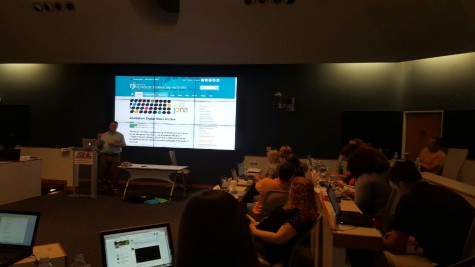Young journalists must take responsibility for digital news archiving
During the Reynolds High School Journalism Institute at the University of Missouri, Edward McCain, the digital curator of journalism for the Donald W. Reynolds Journalism Institute, spoke to teachers about media archiving and the need for every young journalist to take responsibility for their own work.
News archives are used by media organizations searching for background material for a current story and are also some of the most-used collections at libraries. Preserving digital-first news requires different procedures than preserving printed newspapers in digital form.
“Digital preservation is a relatively new concept, and there are still many people out there that don’t know about it or don’t think it will affect them,” McCain said. “The next generation of journalists is going to contend with this for the rest of their careers.”
McCain said it is important for students and teachers to start addressing the issue now and make changes to improve the chances that news articles will exist and be accessible in the year 2025 and beyond.
“I’m convinced that the technology already exists to get this situation moving in the right direction immediately,” he said. “The people who hold the content, news organizations, are not fully aware of how pervasive and potentially devastating the situation is right now.”
McCain cited U.S. News and World Report’s announcement last year that the organization was deleting its web archives of any content prior to 2007.
“This sent many of their contributors into panic since they would lose access to the stories and photos they used for their portfolios,” McCain said.
In 2002, the Columbia Missourian suffered a server crash that ended up destroying 15 years of text and eight years of photos. The newspaper lost years of authoritative coverage that added richness and context to their stories. McCain said the situation could have been avoided.
During his presentation, McCain offered these solutions to teachers and their students:
- Use the Internet Archive’s “Save Page Now” function. (This will only work for sites that allow crawlers)
- Use the print page function from your browser and save it as a PDF file. PDFs are a standard format that should be usable into the foreseeable future.
- Make a print copy. If you have a clean, cool, dry place to store paper, you can keep a hard copy just in case. You can always scan it later if you need to share it.
- Keep lots of copies of your work. Use services, such as Google Drive, Dropbox, Box and others, that give free storage space in the cloud. Whatever you do, don’t keep everything on one drive; when something happens to that drive, your work is gone.
- Use an application, such as Evernote, to make digital clippings of your work. Evernote can then store it in the cloud. The free service is limited to 60 MB a month, but that amount of storage can handle a substantial amount of web clippings.
“Don’t count on anyone else or any institution, no matter how big or well known, to safeguard your stories, photos or other news content,” he said.
McCain, along with a group of researchers at the University of Missouri, found that photography is one of the most popular types of content for people who use new archives. McCain said news archives are also one of the most popular content areas at all libraries.
“As far as their popularity, I think people connect with photographs in an almost instantaneous manner,” he said. “There are no language barriers to photography, and they often communicate feelings or concepts that are difficult, if not impossible, to describe in words.”
For more information, visit the Journalism Digital News Archive or subscribe to the “Dodging the Memory Hole” newsletter.
The Reynolds High School Journalism Institute is geared to help teachers start, reinvigorate or expand secondary-school media programs. Funding for the Institute comes from the Donald W. Reynolds Foundation.
The Institute is funded by the Donald W. Reynolds Foundation, a national philanthropic organization founded in 1954 by the late media entrepreneur for whom it is named. Headquartered in Las Vegas, Nevada, it is one of the largest private foundations in the United States. The American Society of News Editors administers the Institute. ASNE is a nonprofit professional organization formed in 1922 that promotes principled journalism, protects First Amendment rights and fights for open government. Key ASNE initiatives include leadership, innovation, diversity and inclusion, and youth journalism. The ASNE Youth Journalism Initiative created SchoolJournalism.org.



